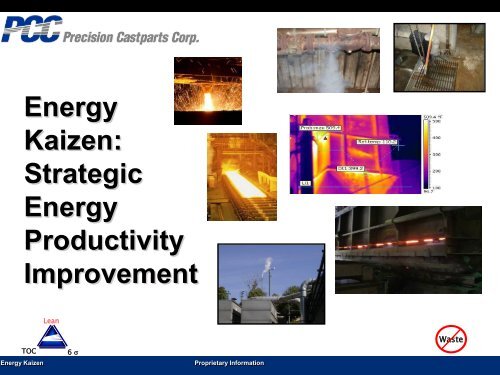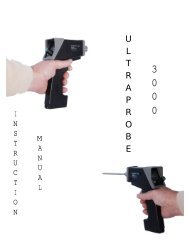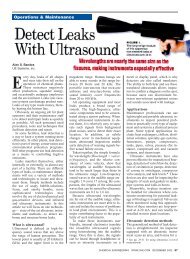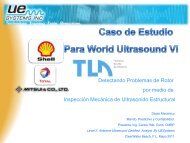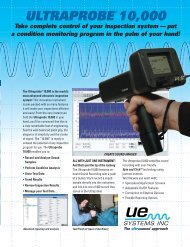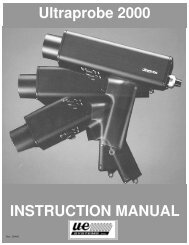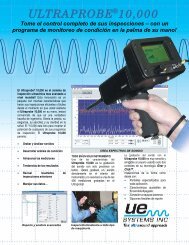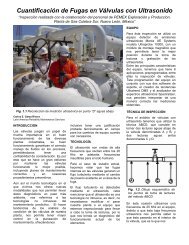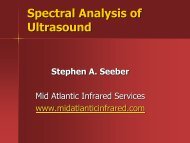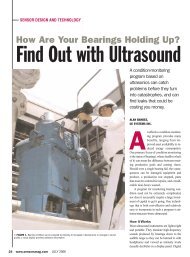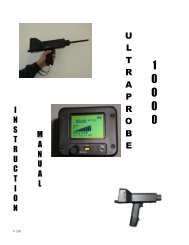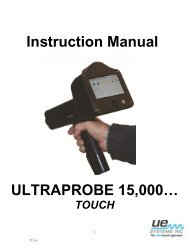Energy Kaizen - UE Systems
Energy Kaizen - UE Systems
Energy Kaizen - UE Systems
You also want an ePaper? Increase the reach of your titles
YUMPU automatically turns print PDFs into web optimized ePapers that Google loves.
<strong>Energy</strong><br />
<strong>Kaizen</strong>:<br />
Strategic<br />
<strong>Energy</strong><br />
Productivity<br />
Improvement<br />
Lean<br />
TOC<br />
<strong>Energy</strong> <strong>Kaizen</strong><br />
6 s<br />
Proprietary Information<br />
Waste
Schedule<br />
• PCC History<br />
• Customers: Boeing, GE, Pratt Whitney, Airbus<br />
• Sectors: aerospace, power generation, medical,<br />
general industrial<br />
• Divisions: castings, forgings, fasteners<br />
• 1955-2005: $0-3B annual revenue<br />
• 2005-2010: $3-6B annual revenue<br />
• Very decentralized organization (108 plants)<br />
Lean<br />
TOC<br />
<strong>Energy</strong> <strong>Kaizen</strong><br />
6 s<br />
Proprietary Information<br />
Waste<br />
2
Schedule<br />
• Nick Balster History<br />
• BS MS&E, University of Wisconsin<br />
• MBA, Babson College (in-process)<br />
• Hired by PCC in 2000<br />
• Operations, technical roles within PCC<br />
• 4 business units, 3 plants, 2 countries<br />
• Corporate <strong>Energy</strong> Manager since 2008<br />
Lean<br />
TOC<br />
<strong>Energy</strong> <strong>Kaizen</strong><br />
6 s<br />
Proprietary Information<br />
Waste<br />
3
Agenda<br />
• Introduction to <strong>Energy</strong> <strong>Kaizen</strong><br />
• Treasure Hunt Model<br />
• Areas of focus<br />
• Large Plant Focus<br />
• SPS-Jenkintown: <strong>UE</strong> (Waetjen) Introduction<br />
• SMC-Huntington: years of focus<br />
• Conclusions<br />
Lean<br />
TOC<br />
<strong>Energy</strong> <strong>Kaizen</strong><br />
6 s<br />
Proprietary Information<br />
Waste<br />
4
Schedule<br />
• <strong>Energy</strong> <strong>Kaizen</strong> Event History<br />
• 2007: pilot at largest plant (external consultants)<br />
• 2008: program built on pilot; internalized<br />
• 2008: corporate-wide program begins<br />
• 2009: 32 events completed; $4.2M implemented savings<br />
• 2010: resource additions to bolster programs<br />
• 2011: energy team developed to drive further savings<br />
• 2012: energy department planned to continue internalizing<br />
Lean<br />
TOC<br />
<strong>Energy</strong> <strong>Kaizen</strong><br />
6 s<br />
Proprietary Information<br />
Waste<br />
5
Schedule<br />
• <strong>Energy</strong> <strong>Kaizen</strong> Event Schedule<br />
• Overview presentation<br />
• Plant tour<br />
• Goals/expectations review: energy productivity<br />
• Review of energy users: asset list<br />
• Review of QuickPEP results<br />
• Utility bill review: meet with our friends at the utilities<br />
• Treasure Hunt: tag leaks, log, maintenance work order placement<br />
• Reflection session: energy board<br />
• GM Staff Presentation<br />
Lean<br />
TOC<br />
<strong>Energy</strong> <strong>Kaizen</strong><br />
6 s<br />
Proprietary Information<br />
Waste<br />
6
Schedule<br />
• Treasure Hunt<br />
• Asset list – write down any missing data (kW, HP, etc.)<br />
• Discuss usage with operators<br />
• Evaluate for shutdown procedures (shift, weekend, shutdowns)<br />
• Reflection meetings<br />
• Quantify savings opportunities<br />
Lean<br />
TOC<br />
<strong>Energy</strong> <strong>Kaizen</strong><br />
6 s<br />
Proprietary Information<br />
Waste<br />
7
Data Collection<br />
• Treasure Hunt Ground Rules<br />
• Ratio FY11 forecast to FY12 forecast: use ratio as a guide<br />
• Brainstorm ‘likely suspects’: NG, process gases, CA, electricity<br />
• Asset list: touch every piece of equipment<br />
• Need average numbers/hour<br />
• Determine sizes of all leaks; write tags<br />
• Collect all forms of energy waste (lights left on, motors running,<br />
pumps, blowers, compressors, etc.) – document<br />
Lean<br />
TOC<br />
<strong>Energy</strong> <strong>Kaizen</strong><br />
6 s<br />
Proprietary Information<br />
Waste<br />
8
<strong>Energy</strong> Waste: Examples<br />
Compressed Air Leak<br />
(Process Defect)<br />
Excess Fuel Usage<br />
(Motion, Over Production, Transportation)<br />
Steam Leak<br />
(Process Defect)<br />
Water Spills<br />
(Over Processing)<br />
TOC<br />
<strong>Energy</strong> <strong>Kaizen</strong><br />
Lean<br />
6 s<br />
Proprietary Information<br />
Waste<br />
9
<strong>Energy</strong> Waste: Examples<br />
Poorly functioning HVAC<br />
Inefficient Lighting<br />
Water Leak<br />
Waste Heat Release<br />
TOC<br />
<strong>Energy</strong> <strong>Kaizen</strong><br />
Lean<br />
6 s<br />
Proprietary Information<br />
Waste<br />
10
<strong>Energy</strong> Waste: Examples<br />
Compressed Air Intake Indoors<br />
Inefficient Motors<br />
Bare Piping<br />
Poor Air/Fuel Ratio<br />
TOC<br />
<strong>Energy</strong> <strong>Kaizen</strong><br />
Lean<br />
6 s<br />
Proprietary Information<br />
Waste<br />
11
Some Examples Of <strong>Energy</strong> Waste<br />
• Machines left running when not in<br />
operation<br />
• Running oversized motors<br />
• Running motors beyond optimum load<br />
requirement<br />
• Using more than minimum air pressure<br />
to operate machinery<br />
• Oven or freezer temperatures are set<br />
above/below optimum<br />
• Lack of shutdown procedures<br />
• Excess assets in downturns (% basis)<br />
• Employee control of temperature<br />
settings<br />
• Lighting not controlled by motion<br />
sensors<br />
• Poor maintenance & work methods<br />
• Lack of formal system to track energy<br />
usage/waste<br />
• Lights left on<br />
• Machines left on during breaks<br />
• Lack of communication on energy spend<br />
TOC<br />
<strong>Energy</strong> <strong>Kaizen</strong><br />
Lean<br />
6 s<br />
Proprietary Information<br />
Waste<br />
12
IMPACT<br />
Prioritize – Death by a Thousand<br />
Paper Cuts<br />
9<br />
5<br />
8<br />
12<br />
9<br />
6<br />
1<br />
5<br />
4<br />
3<br />
3<br />
2<br />
10<br />
7<br />
Lean<br />
TOC<br />
<strong>Energy</strong> <strong>Kaizen</strong><br />
6 s<br />
3<br />
5<br />
EASE<br />
Proprietary Information<br />
9<br />
Waste<br />
13
Agenda<br />
• Introduction to <strong>Energy</strong> <strong>Kaizen</strong><br />
• Treasure Hunt Model<br />
• Areas of focus<br />
• Large Plant Focus<br />
• SPS-Jenkintown: <strong>UE</strong> (Waetjen) Introduction<br />
• SMC-Huntington: years of focus<br />
• Conclusions<br />
Lean<br />
TOC<br />
<strong>Energy</strong> <strong>Kaizen</strong><br />
6 s<br />
Proprietary Information<br />
Waste<br />
14
Large Plant Focus<br />
• SPS-Jenkintown ($2-3M annual spend); 2008<br />
• Largest fastener plant in PCC<br />
• Aerospace bolts, nuts, pins<br />
• 1000s of machine tools<br />
• Whole plant assessment; little experiences with<br />
energy<br />
• Team of 6<br />
Lean<br />
TOC<br />
<strong>Energy</strong> <strong>Kaizen</strong><br />
6 s<br />
Proprietary Information<br />
Waste<br />
15
Large Plant Focus<br />
• SPS-Jenkintown: 3-day Event<br />
• Compressed Air <strong>Systems</strong><br />
• <strong>UE</strong> introduction to PCC<br />
• Lighting systems<br />
• Motors and drives<br />
• PLC controls<br />
• Demand Response<br />
Lean<br />
$363k annualized<br />
savings implemented<br />
to date<br />
TOC<br />
<strong>Energy</strong> <strong>Kaizen</strong><br />
6 s<br />
Proprietary Information<br />
Waste<br />
16
Some Examples from the Field<br />
TOC<br />
<strong>Energy</strong> <strong>Kaizen</strong><br />
Lean<br />
6 s<br />
Proprietary Information<br />
Waste<br />
17
Large Plant Focus<br />
• Special Metals-Huntington ($20-25M); 2007 start<br />
• Combustion <strong>Systems</strong><br />
• Compressed Air <strong>Systems</strong><br />
• Lighting systems<br />
• Motors and drives<br />
• PLC controls<br />
• Demand Response<br />
Lean<br />
$2,265k annualized<br />
savings implemented<br />
to date<br />
TOC<br />
<strong>Energy</strong> <strong>Kaizen</strong><br />
6 s<br />
Proprietary Information<br />
Waste<br />
18
Sustain the Gains<br />
TOC<br />
<strong>Energy</strong> <strong>Kaizen</strong><br />
Lean<br />
6 s<br />
Proprietary Information<br />
Waste
Management Reviews: MBWA<br />
Conducted Twice Monthly:<br />
• TBD at TBD am/pm<br />
• TBD at TBD am/pm<br />
Objective:<br />
• Senior management debriefing and audit of process<br />
• Direct communications between senior management and operators<br />
• Communicate & recalibrate priorities, consensus on focus<br />
Format:<br />
• Standing meeting 10 to 15 minutes maximum<br />
• Not a problem solving session. Assign responsibility for follow-up if necessary.<br />
Agenda:<br />
• Latest usage data and trend versus target.<br />
• Standard Procedures Updates<br />
• <strong>Kaizen</strong> Newspaper Activity<br />
Lean<br />
TOC<br />
<strong>Energy</strong> <strong>Kaizen</strong><br />
6 s<br />
Proprietary Information<br />
Waste<br />
20
Empowerment<br />
TIPS - Utility Cost Reduction<br />
Electricity<br />
Gas<br />
Water<br />
Turn off all air blowoffs and air knives when your machine is not running (even if it's only a few minutes)<br />
Turn off machine motors when not in use (Ex: Rollers, scrap and work conveyors)<br />
Disconnect air tools from air line when not in use.<br />
Immediately report air leaks to your supervisor, no matter how small.<br />
Turn off shop lights when an area will be unoccupied for at least an hour (Ex: Maintenance, CNC department, sorting)<br />
Turn off office lights if room is not in use.<br />
Avoid jogging multiple headers at once to reduce peak usage penalty (Will require operator awareness and teamwork)<br />
Turn off work lights when not in use (Ex: Work lights in header die areas)<br />
Use power saver features on office equipment (printers, monitors, etc) and turn off computers and printers at night.<br />
Do not remove, alter, or discard energy efficient devices without supervisor permission (Ex: Nozzles on blowoffs)<br />
Replace inefficient space heaters with energy efficient models<br />
Turn off General Drive air compressor immediately at end of shift.<br />
Never turn office thermostats above 68 degrees.<br />
Lower temperature on office thermostats to 60 degrees when leaving for the night (Last person out).<br />
Turn on shop heaters only when absolutely necessary.<br />
Close all outside doors when heaters are in use.<br />
Use oil skimmers on parts washers to prevent water contamination<br />
Report any leaky or defective plumbing to your supervisor.<br />
TOC<br />
<strong>Energy</strong> <strong>Kaizen</strong><br />
Lean<br />
6 s<br />
Proprietary Information<br />
Waste<br />
21
You can do it<br />
• Conclusions<br />
• Any organization can successfully implement this, if:<br />
• YOU make energy a priority<br />
• YOU are passionate about improving productivity<br />
• Recommendations<br />
• Contact your utilities – rates<br />
• Run your organizations numbers<br />
Lean<br />
TOC<br />
<strong>Energy</strong> <strong>Kaizen</strong><br />
6 s<br />
Proprietary Information<br />
Waste<br />
22


